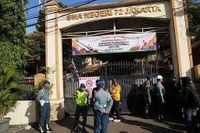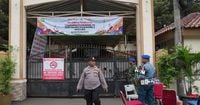On November 7, 2025, chaos erupted at SMA 72, a state high school nestled within a navy compound in Jakarta’s northern Kelapa Gading neighborhood. What should have been a peaceful Friday prayer service inside the campus mosque was shattered by a pair of explosions that sent gray smoke billowing and nearly a hundred people—mostly students—scrambling for safety. As the dust settled, Indonesian authorities began piecing together a disturbing puzzle that has left the city on edge and the nation searching for answers.
The incident unfolded just as the Friday sermon began, according to eyewitnesses who spoke to local television stations and the Associated Press. "We heard at least two loud blasts around midday, from inside and outside the mosque," one witness recounted. Panic swept through the congregation as students and others ran out, choking on smoke and dodging shards of glass. The immediate aftermath saw 54 people injured, with about 33 students hospitalized for burns and wounds from flying fragments, reported AP.
Authorities quickly identified the suspect: a 17-year-old male student from the very school where the attack occurred. He, too, was injured in the blasts and was undergoing surgery as police launched an intensive investigation. Deputy House Speaker Sufmi Dasco Ahmad, after visiting victims at a local hospital, told reporters, "The suspect is a 17-year-old male student." National Police Chief Listyo Sigit, speaking from the presidential palace, confirmed that the suspect was one of two students in surgery and emphasized the ongoing efforts to understand not just the suspect’s identity, but the environment in which he lived.
Police wasted no time searching the suspect’s home. According to AP, they found explosive powder and a trove of writings, now being analyzed for possible links to hate groups. This discovery deepened the mystery of what could have driven a teenager to orchestrate such a violent act. Authorities are now investigating whether the suspect was radicalized in the lead-up to the attack, as reported by Reuters and ABC News.
One of the most chilling pieces of evidence recovered was a toy submachine gun, which the suspect had inscribed with white supremacist slogans. Among the markings were the phrases "14 words. For Agartha," and "Brenton Tarrant: Welcome to hell." Police Chief Sigit explained, "We discovered the weapon was a toy gun with specific markings, which we are also investigating to understand the motive, including how he assembled it and carried out the attack." The "14 words" phrase is widely recognized as a white supremacist slogan, and Brenton Tarrant is the convicted perpetrator of the 2019 mass shooting at a mosque in Christchurch, New Zealand—a reference that sent chills down the spines of investigators and the public alike.
Despite these troubling signs, officials have urged caution in jumping to conclusions about the nature of the attack. Jakarta Police Chief Asep Edi Suheri warned against speculating that the incident was a terror attack before the investigation is complete. "Our personnel are currently conducting an in-depth investigation to determine the suspect's identity and the environment where he lives, including his house and others," Sigit said at a news conference. The police are also looking into the possibility that bullying played a role in motivating the suspect. Jakarta Police spokesperson Budi Hermanto told reporters, "We are still investigating the possibility that bullying was a factor that motivated the suspect to carry out the attack."
Local media reports have suggested that the suspect, a grade 12 student, may have been bullied and sought revenge in what some described as an intended suicide attack. However, with many witnesses still recovering from their injuries, police say there are "several obstacles in obtaining information from witnesses as they are also victims who need medical treatment to recover," according to Hermanto. In the meantime, authorities have begun providing trauma counseling to affected students and teachers, seeking to restore a sense of safety and normalcy to the shaken school community.
Most of the injuries sustained in the blast were burns and wounds from flying glass. Many of those closest to the mosque’s loudspeaker suffered hearing loss from the force of the explosions. The exact type of explosives used remains unknown, but police confirmed that the blasts originated near the mosque’s loudspeaker.
Security forces responded swiftly to the incident, cordoning off the area and assuring the public that the capital’s security was under control. "The capital is safe and security is under control," Hermanto reassured the press late Friday. Images from the scene showed armed police and military personnel standing guard at the school gates, while bomb squad members combed through the mosque for evidence. Onlookers gathered nearby, their faces etched with worry and disbelief.
The broader context of the attack has left Indonesia grappling with difficult questions about youth radicalization, hate speech, and school safety. The references to white supremacist ideology, particularly the invocation of Brenton Tarrant’s name, have raised alarms in a country that has seen its share of extremist violence but rarely from such a young perpetrator. Authorities are now combing through the suspect’s writings and online activity, searching for any links to hate groups or radical influences that might explain his actions.
As the investigation continues, officials are urging the public and the media to avoid spreading rumors or unverified information. The police have been clear that they are considering all possible motives, from personal grievances like bullying to more organized forms of radicalization. "There are several pieces of supporting evidence at the suspect’s house," police told ABC News, but the full picture of what drove this attack is still coming into focus.
In the days following the explosion, the school community has rallied to support the injured and one another. Hospitals remain busy treating the 33 students still recovering from burns and blast wounds, while counselors work to help survivors process the trauma. The mosque, once a place of reflection and peace, now bears the scars of violence but also the determination of a community to heal.
While Jakarta’s streets have returned to a semblance of normalcy, the questions raised by this attack linger—about the vulnerabilities of youth, the reach of extremist ideologies, and the steps needed to prevent such tragedies in the future.

